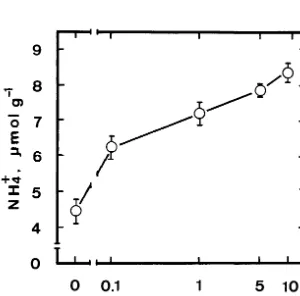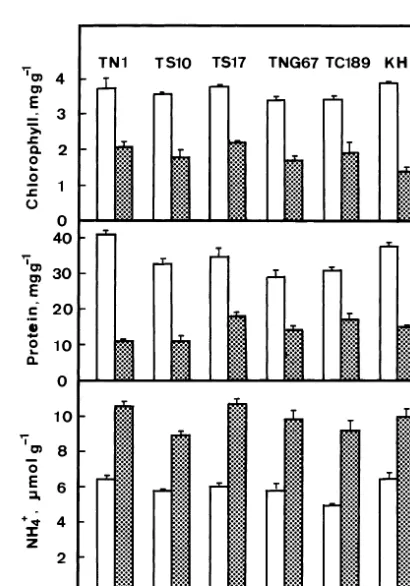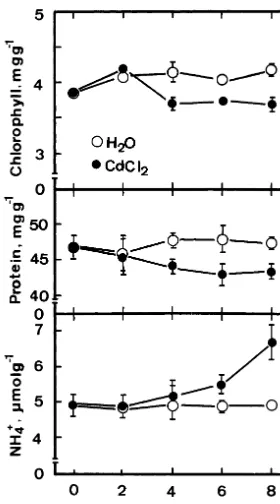Accumulation of ammonium in rice leaves in response to excess
cadmium
Hsiu-Fang Chien, Ching Huei Kao *
Department of Agronomy,National Taiwan Uni6ersity,Taipei, Taiwan,ROC
Received 8 November 1999; received in revised form 24 February 2000; accepted 24 February 2000
Abstract
The relationship between ammonium accumulation and senescence of detached rice leaves caused by excess cadmium (Cd) was investigated. CdCl2was effective in increasing ammonium content in detached rice leaves under both light and dark conditions.
Both CdCl2 and CdSO4 induced ammonium accumulation in detached rice leaves, indicating that ammonium accumulation is
induced by Cd ions. CdCl2-promoted senescence and ammonium accumulation is not specific for the rice cultivar used in this
study. The senescence of detached rice leaves induced by CdCl2was found to be prior to ammonium accumulation. CdCl2induces
more ammonium accumulation in the dark than in the light. However, CdCl2 treatment was found to be less effective in
promoting senescence in the dark than in the light. The current results suggest that ammonium accumulation is not associated with the senescence of detached rice leaves induced by Cd. Evidence was presented to show that CdCl2-induced ammonium
accumulation in detached rice leaves is attributed to a decrease in glutamine synthetase (GS) activity. © 2000 Elsevier Science Ireland Ltd. All rights reserved.
Keywords:Ammonium; Cadmium; Glutamine synthetase; Leaf senescence;Oryza sati6a
www.elsevier.com/locate/plantsci
1. Introduction
Cadmium, a non-essential toxic element, enters the environment through industrial process and to a lesser extent from natural weathering [1]. Studies on its accumulation and effect on plants reveal that this metal is strongly phytotoxic [1,2]. In Taiwan, Cd poses a serious problem for rice production.
Ammonium is a central intermediate of nitrogen metabolism in plants [3]. High content of ammo-nium is known to have toxic effects in plant cells [4]. Ammonium has been shown to accumulate in leaves subjected to water stress, when exposed to excess Cu, and during dark-induced senescence
[5 – 9]. The effect of Cd stress on nitrogen metabolism has been very little investigated [10]. Nitrate reductase and glutamine synthetase (GS) activities decrease with Cd stress [10 – 14]. Decline in activity of GS in leaves by excess Cd may result, at least in part, in an accumulation of ammonium in leaves. Excess Cd has been shown to enhance leaf senescence [15]. Recently, we reported that ammonium accumulation is associated with water stress- and dark-induced senescence of detached rice leaves [5,7]. Relatively little work has been done to study the effect of Cd on ammonium accumulation. Neither do we know the relation-ship between ammonium accumulation and Cd-in-duced leaf senescence. Thus it is of great interest to know the role of ammonium in regulating Cd-induced senescence of detached rice leaves. The possible reasons of ammonium accumulation during Cd-induced senescence in detached rice leaves are also investigated in the present study.
Abbre6iations:GS, glutamine synthetase. * Corresponding author. Fax: +886-2-23620879.
E-mail address:[email protected] (C.H. Kao)
2. Materials and methods
Rice (Oryza sati6a cv. Taichung Native 1) was cultured as previously described [16]. Briefly, rice seedling were planted on a stainless net floating on half-strength Johnson’s modified nutrient solution (pH 4.2) in a 500-ml beaker. The nutrient solution was replaced every 3 days. Rice plants were grown for 12 days in a greenhouse, where natural light was provided and the temperature was controlled at 30°C during the day and at 25°C at night. The apical 3 cm of the third leaf was used for the experiment. A group of ten segments was floated in a Petri dish containing 10 ml of test solutions. Incubation was carried out at 27°C in darkness or in the light (40 mmol m−2 s−1).
The senescence of detached rice leaves was fol-lowed by measuring the decrease of chlorophyll and protein. Chlorophyll was determined accord-ing to Wintermans and De Mots [17] after extrac-tion in 96% (v/v) ethanol. For protein extraction, leaf segments were homogenized in 50 mM sodium phosphate buffer (pH 6.8). The extracts were cen-trifuged at 17 600×g for 20 min, and the super-natants were used for determination of protein by the method of Bradford [18].
Ammonium was extracted by homogenizing leaf segments in 0.3 mM sulphuric acid (pH 3.5). The homogenate was centrifuged for 10 min at 39 000×g and the supernatant was used for de-termination of ammonium as described by Lin and Kao [19]. For nitrate determination, leaf segments were homogenized and centrifuged for 25 min at
17 600×g. The supernatant used was according to Hecht and Mohr [20].
For extraction of GS, leaf segments were ho-mogenized with 10 mM Tris – HCl buffer (pH 7.6, containing 1 mM MgCl2, 1 mM EDTA and 1 mM
2-mercaptoethanol) in a chilled pestle and mortar. The homogenate was centrifuged at 15 000×gfor 30 min and the resulting supernatant was used for determination of GS activity. The whole extrac-tion procedure was carried out at 4°C. GS was assayed by the method of Oaks et al. [21]. The reaction mixture contained in a final volume of 1 ml was 80 mmol Tris – HCl buffer, 40 mmol L
-glu-tamic acid, 8 mmol ATP, 24 mmol MgSO4, and 16 mmol NH2OH; the final pH was 8.0. The reaction
was started by addition of the enzyme extract and, after incubation for 30 min at 30°C, was stopped by adding 2 ml 2.5% (w/v) FeCl3 and 5% (w/v)
trichloroacetic acid in 1.5 M HCl. After centrifu-gation the absorbance of the supernatant was read at 540 nm. The definition of 1 U of GS activity is defined as 1 mmol L-glutamate g
-monohydroxam-ate formed per min.
Chlorophyll, protein, ammonium and nitrate contents and GS activity were expressed per g fresh weight. Absolute levels of each measurement varied among experiments because of seasonal effects. However, the patterns of responses to CdCl2 were reproducible. For all measurements,
each treatment was repeated four times. All exper-iments described here were repeated at least three times. Similar results and identical trends were obtained each time. The data reported here are from a single experiment.
3. Results and discussion
Increasing concentration of CdCl2from 0.1 to 5
mM progressively increased ammonium content in detached rice leaves in the light (Fig. 1). No further increase was observed at 10 mM CdCl2.
Ammonium content increased 2- and 3.5-fold in
detached rice leaves treated with 5 mM CdCl2 for
48 h in the light and in the dark, respectively (Fig. 2). It is obvious that under light and dark condi-tions, CdCl2 is effective in increasing ammonium
content in detached rice leaves. When the effect of CdSO4 on ammonium content of detached rice
leaves was compared with that of CdCl2, it was
found that CdSO4 and CdCl2 were equally
effec-tive in inducing ammonium accumulation under
Fig. 1. Effect of CdCl2 on ammonium content in detached
rice leaves. Detached rice leaves were incubated in solutions containing 0 – 10 mM CdCl2. Ammonium was determined 48
Fig. 2. Effect of light and dark on chlorophyll, protein and ammonium contents in detached rice leaves. Detached rice leaves were treated with water, 5 mM CdCl2or 5 mM CdSO4.
Chlorophyll, protein and ammonium were determined 48 h after treatment. Vertical bars represent standard errors (n=
4).
ter stress- and dark-induced senescence of de-tached rice leaves [5,7]. If ammonium accumulation plays an important role in regulating senescence of detached rice leaves, then the pro-motion of leaf senescence by CdCl2 is expected to
occur after the accumulation of ammonium. How-ever, the promotion of senescence by CdCl2 was
observed to occur 4 h after treatment, which is prior to the accumulation of ammonium (Fig. 4). Fig. 2 shows that CdCl2 induces more ammonium
accumulation in the dark than in the light. How-ever, CdCl2 treatment was found to be less
effec-tive in promoting senescence in the dark than in the light (Fig. 2). Thus, the earlier indication that senescence of detached rice leaves is directly linked to ammonium accumulation [5,7] does not hold for CdCl2-induced senescence in detached rice
leaves.
Ammonium ion is a central intermediate in the metabolism of nitrogen in plants [3]. Ammonium is produced during nitrate assimilation,
deamina-Fig. 3. Effect of CdCl2 on chlorophyll, protein, and
ammo-nium contents of six rice varieties. KH, Koshhikari; TN1, Taichung Native 1; TS10, Taichung Sen 10; TS17, Taichung Sen 17; TNG67; Tainung 67; TC189, Taichung 189. Detached rice leaves were treated with either water (open columns) or 5 mM CdCl2 (shaded columns) for 48 h in the light. Bars
represent standard errors (n=4).
both light and dark conditions (Fig. 2), indicating that ammonium accumulation is induced by Cd ions rather by SO42− or Cl−. Fig. 2 also shows that
CdSO4 and CdCl2 were equally effective in
pro-moting senescence of detached rice leaves, judged by a decrease in chlorophyll and protein contents. The effect of CdCl2 on ammonium
accumula-tion is unlikely to be specific for the particular rice cultivar used in this study, since CdCl2 also
in-creased ammonium of detached rice leaves of five other cultivars of rice (Fig. 3). As is also clear from Fig. 3, CdCl2 promoted senescence of
de-tached rice leaves of all cultivars tested.
Ammonium content in control leaves remained almost unchanged during 8 h of incubation in the light (Fig. 4). It is clear that accumulation of ammonium induced by CdCl2 was evident at 6 h
after treatment. Recently, we reported that exoge-nous NH4Cl promoted rice leaf senescence [7] and
wa-Fig. 4. Time course of the CdCl2 effect on chlorophyll,
protein, and ammonium contents in detached rice leaves in the light. Detached rice leaves were incubated in water or 5 mM CdCl2. Vertical bars represent standard errors (n=4).
Only those standard errors larger than the symbol are shown. Fig. 5. Time course of the CdCl2 effect on ammonium and
nitrate contents, and GS activity in detached rice leaves in the light. Detached rice leaves were incubated in water or 5 mM CdCl2. Vertical bars represent standard errors (n=4). Only
those standard errors larger than the symbol are shown.
tion of amino acids and photorespiration [3]. Fig. 5 shows that CdCl2 treatment had no effect on
nitrate content. This result suggested that CdCl2
-in-duced ammonium accumulation is unlikely to have resulted from the promotion of reduction of nitrate. GS is the primary enzyme responsible for ammo-nium assimilation in plants [3]. We observed that GS activity in control leaves remained unchanged during 48 h of incubation and CdCl2-treated rice
leaves had lower GS activity than the control leaves (Fig. 5). It seems that CdCl2-induced ammonium
accumulation is attributed to the decrease in GS activity.
Acknowledgements
This work was supported by grant NSC 88-2313-B002-066 from the National Science Council of the Republic of China.
References
[1] L.S. di Toppi, R. Gabbrieli, Reponse to cadmium in higher plants, Environ. Exp. Bot. 41 (1999) 105 – 130.
[2] H. Clysters, F. Van Assche, Inhibition of photosynthesis by metal, Phytosyn. Res. 7 (1985) 31 – 40.
[3] B.J. Miflin, P.J. Lea, The pathway of nitrogen assimila-tion in plants, Phytochemistry 15 (1976) 873 – 885. [4] H. Marchner, Mineral Nutrition of Higher Plants,
Aca-demic Press, San Diego, 1995, pp. 1 – 889.
[5] J.-N. Lin, C.H. Kao, Water stress, ammonium, and leaf senescence in detached rice leaves, Plant Growth Regul. 26 (1998) 165 – 169.
[6] L.-M. Chen, C.H. Kao, Relationship between ammo-nium accumulation and senescence of detached rice leaves caused by excess copper, Plant Soil 200 (1998) 169 – 173.
[7] S.J. Chen, K.T. Hung, C.H. Kao, Ammonium accumula-tion is associated with senescence of rice leaves, Plant Growth Regul. 21 (1997) 195 – 201.
[8] K.M.U. Peeters, A.J. Van Laere, Ammonium and amino acid metabolism in excised leaves of wheat (Triticum aesti6um) senescing in the dark, Physiol. Plant. 84 (1992)
243 – 249.
[9] H. Thomas, Enzymes of nitrogen mobilization in de-tached leaves of Lolium temulentum during senescence, Planta 142 (1978) 161 – 169.
[11] H.-J. Weigel, H.-J. Jagar, Different effect of cadmium in vitro and in vivo on enzyme activities in bean plants (Pheseolus 6ulgaris L. cv. Sankt Andreas), Z.
Pflanzen-physiol. 97 (1980) 103 – 113.
[12] L.K. Chugh, V.K. Gupta, S.K. Sawhney, Effect of cad-mium on enzymes of nitrogen metabolism in pea seedlings, Phytochemistry 31 (1992) 395 – 400.
[13] R.P. Singh, N. Bharti, G. Kumar, Differential toxicity of heavy metals to growth and nitrate reductase activity of Sesamum indicum seedlings, Phytochemistry 35 (1994) 1153 – 1156.
[14] O. Ouariti, H. Gouia, M.H. Ghorbal, Responses of bean and tomato plants to cadmium: growth, mineral nutri-tion, and nitrate reducnutri-tion, Plant Physiol. Biochem. 35 (1997) 347 – 354.
[15] S.M. Gallego, M.P. Benavides, M.L. Tomaro, Effect of heavy metal ion excess on sunflower leaves: evidence for involvement of oxidative stress, Plant Sci. 121 (1996) 151 – 159.
[16] C.H. Kao, Senescence of rice leaves IV. Influence of
benzyladenine on chlorophyll degradation, Plant Cell Physiol. 21 (1980) 1255 – 1262.
[17] J.F.G.M. Wintermans, A. De Mots, Spectrophotometric characteristics of chlorophyll a and b and their phro-phytins in ethanol, Biochem. Biophys. Acta 109 (1965) 448 – 453.
[18] M.M. Bradford, A rapid and sensitive method for the quantitation of microgram quantities of protein utilizing the principle of protein-dye binding, Anal. Biochem. 72 (1976) 248 – 254.
[19] C.C. Lin, C.H. Kao, Disturbed ammonium assimilation is associated with growth inhibition of roots in rice seedlings caused by NaCl, Plant Growth Regul. 18 (1996) 133 – 138.
[20] U. Hecht, H. Mohr, Factors controlling nitrate and ammonium accumulation in mustard (Sinapis alba) seedlings, Physiol. Plant. 78 (1990) 379 – 387.
[21] A. Oaks, J. Stulen, K. Jones, M.J. Winspear, I.L. Booesel, Enzymes of nitrogen assimilation in maize roots, Planta 148 (1980) 477 – 484.


